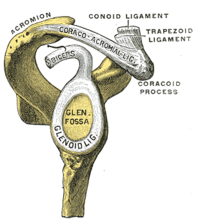
Photo from wikipedia
For overhead athletes and, in particular, baseball pitchers, the rates of success and return to play for those who have undergone arthroscopic repair of type II SLAP lesions are poor,… Click to show full abstract
For overhead athletes and, in particular, baseball pitchers, the rates of success and return to play for those who have undergone arthroscopic repair of type II SLAP lesions are poor, ranging from 7% to 62%. The reasons for the poor results and high failure rates in overhead athletes with type II SLAP repairs are multifactorial and are a combination of many factors. These factors include the failure to establish the diagnosis and treat these athletes preoperatively; the inability of the operating surgeon to differentiate normal anatomic variants from pathologic SLAP lesions at the time of surgery; the surgical technique, which may violate the rotator cuff; or the placement of suture anchors, which restricts external rotation and alters overhead throwing mechanics. The proper diagnosis of SLAP lesions can be difficult because SLAP tears rarely occur in isolation and are often associated with other shoulder pathology. A proper history detailing the onset of symptoms and whether there was an acute episode of trauma or a history of repetitive use is critical. It is important to remember that no single physical examination finding is pathognomonic for SLAP tears. When seen in isolation, SLAP tears may mimic impingement syndrome (52%) or even anterior instability (39%). Surgical treatment of type II SLAP lesions should not be undertaken lightly in overhead athletes. If a 3-month rehabilitation period followed by a return to sports over the following 3 months does not allow the athlete to return to his or her preinjury level, diagnostic arthroscopy with SLAP repair is a reasonable option and can yield excellent results using the proper techniques. The technique described in detail in this article and our video can be technically demanding, but with the key points outlined, it can be reproduced and provide excellent results for overhead athletes undergoing SLAP repair. By not violating the rotator cuff, using a mattress configuration and keeping the suture knot away from the articular surface, and by not going anterior to the biceps tendon for repair, external rotation and strength can be preserved, leading to an excellent result with a predictable return to play for overhead athletes.
Journal Title: Arthroscopy Techniques
Year Published: 2019
Link to full text (if available)
Share on Social Media: Sign Up to like & get
recommendations!